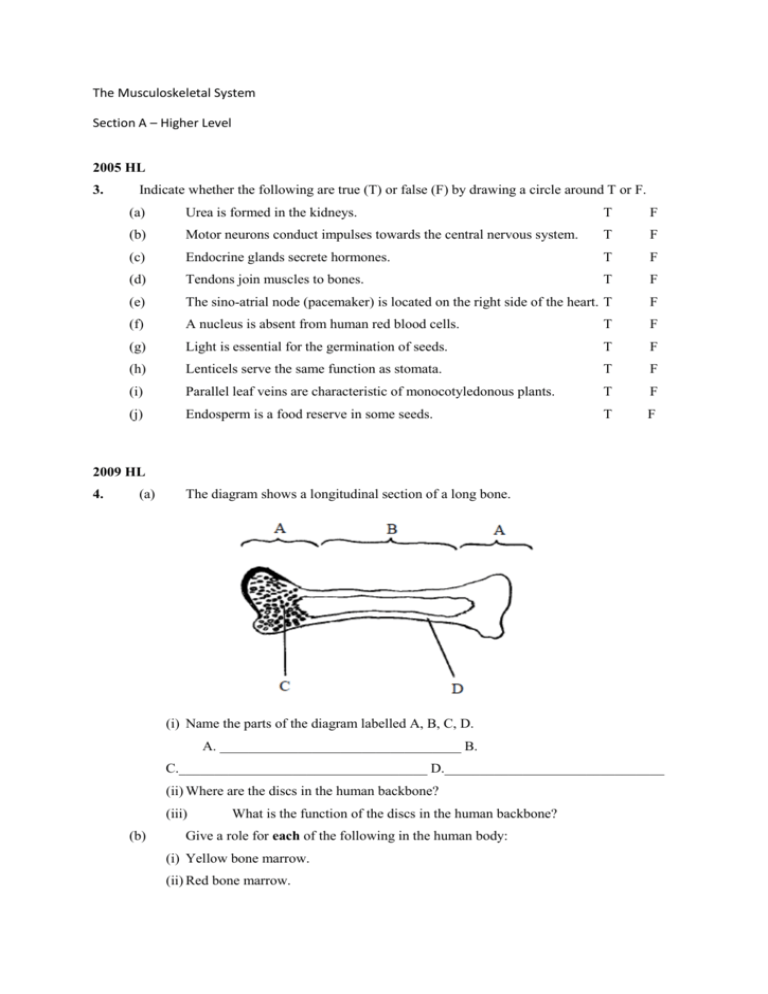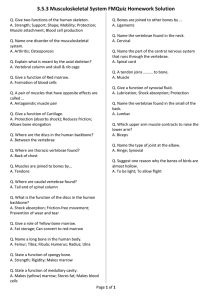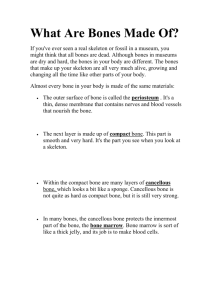The MusculoSkeletal System
advertisement

The Musculoskeletal System Section A – Higher Level 2005 HL 3. Indicate whether the following are true (T) or false (F) by drawing a circle around T or F. (a) Urea is formed in the kidneys. T F (b) Motor neurons conduct impulses towards the central nervous system. T F (c) Endocrine glands secrete hormones. T F (d) Tendons join muscles to bones. T F (e) The sino-atrial node (pacemaker) is located on the right side of the heart. T F (f) A nucleus is absent from human red blood cells. T F (g) Light is essential for the germination of seeds. T F (h) Lenticels serve the same function as stomata. T F (i) Parallel leaf veins are characteristic of monocotyledonous plants. T F (j) Endosperm is a food reserve in some seeds. T F 2009 HL 4. (a) The diagram shows a longitudinal section of a long bone. (i) Name the parts of the diagram labelled A, B, C, D. A. __________________________________ B. C.___________________________________ D._______________________________ (ii) Where are the discs in the human backbone? (iii) (b) What is the function of the discs in the human backbone? Give a role for each of the following in the human body: (i) Yellow bone marrow. (ii) Red bone marrow. 2012 HL 3. (a) The diagram shows the macroscopic structure of part of a long bone. (i) Name a long bone in the human body. __________________________________________ (ii) Name parts X, Y and Z in the diagram. X. Y. Z. (b) (iii) State a function of X. (iv) State a function of Y. (i) Show clearly on the diagram where you would expect to find cartilage. (ii) State one role of this cartilage. Section A – Ordinary Level SEC Sample Paper OL 1. Complete the following sentence by putting one word in the blank space. (a) The hammer (malleus) is a very small bone located in the (b) Bile is secreted by the (c) Tiny holes called ……………………… allow gases to enter and leave the leaf. (d) Bones are joined to other bones by (e) An animal that eats both plants and animals is called an 2004 OL 1. (a) The hepatic portal vein carries blood from the alimentary canal to the (b) A tendon joins ………………………………………… to bone. (c) Phototropism is the growth response of a plant to (d) Hormones are secreted by ………..… glands. (e) Gas exchange between a leaf and the atmosphere takes place through the 2004 OL 4. The diagram shows the structure of one type of joint. Name this type of joint. ………………………………………………………………………… Give one location in the human body of this type of joint. …………………………………….. Name the following parts. A ……………………………………… B ……………………………………… C ……………………………………… Name another type of joint found in the human body …………………………………………. 2007 OL 6. Study the diagram of a synovial joint and then answer the following questions A B C (a) Name tissue A ………………………………………………………. (b) Give a function of A ………………………………………………………. (c) Name tissue B ………………………………………………………. (d) Name the fluid in C ………………………………………………………. (e) Give a function of the fluid in C ………………………………………………………. 2011 OL 4. Indicate whether each of the following statements is true (T) or false (F) by drawing a circle around T or F in each case. Example: The liver produces bile T F (a) The semicircular canals in the ear are involved in balance. T F (b) The growth response of a plant to light is called phototropism. T F (c) Tendons attach bone to bone. T F (d) A motor neuron carries impulses to the brain. T F (e) Rhizopus is a member of the animal kingdom. T F (f) Xylem transports water in plants. T F (g) A potato is a modified stem. T F Section C – Higher Level 2005 HL 14. Answer any two of (a), (b), (c). (30,30) (c) Answer the following questions in relation to systems of response to stimuli in the human body. (i) The pancreas is both an exocrine gland and an endocrine gland. Explain the underlined terms. (ii) Name a product of the endocrine portion of the pancreas and state one of its functions. (iii) Name a disorder other than cancer for each of the following and indicate a possible cause and a means of treatment: 1. Musculoskeletal system 2. Nervous system. 2006 HL 15. Answer any two of (a), (b) and (c). (30, 30) (a) (i) (ii) (iii) (iv) Draw a diagram to show the structure of a synovial joint. Label three parts of the joint that you have drawn, other than bones. Explain the functions of the three parts that you have labelled. Name a disorder of the musculoskeletal system. Give a possible cause of the disorder that you have named in (iii) and suggest a treatment for it. 2008 HL 15. (a) Answer the following questions in relation to the human musculoskeletal system. (i) (ii) (iii) (iv) (v) Give three roles of the skeleton. Explain what is meant by the axial skeleton. Give a function for each of the following: 1. Red marrow, 2. Cartilage, 3. Tendon. Explain what is meant by an antagonistic muscle pair and give an example in the human body. Suggest a treatment for a named disorder of the musculoskeletal system. Section C – Ordinary Level 2006 OL 15. (c) (i) (ii) 1. 2. (iii) (iv) (v) State two functions of the human skeleton. The vertebrae form part of the axial skeleton. Name the vertebrae found in: The neck, The small of the back. Name the part of the central nervous system that runs through the vertebrae. Name the three bones that form the human arm. Write a short note (about five lines) on one of the following: arthritis or osteoporosis. 2010 OL 15. Answer any two of the parts (a), (b), (c). (30, 30) (b) The diagram shows the bones of the human arm. (i) Name the parts labelled A, B and C. (ii) What structures attach a muscle to a bone? (iii) Which upper arm muscle contracts to raise the lower arm? (iv) What is meant by the term antagonistic pair in reference to muscles? (v) Name the type of joint at the elbow. (vi) Apart from movement, give one other function of the skeleton. (vii) Suggest one reason why the bones of birds are almost hollow.











